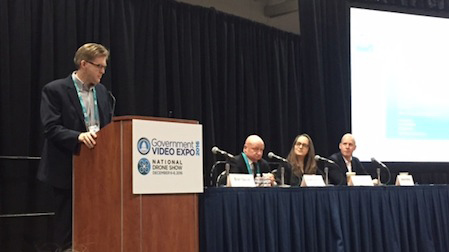GV Expo: VR, AR Establishing Presence Across Industry
WASHINGTON—William Anthony, director of television and motion pictures for the U.S. Customs and Border Protection agency, cited a Nobel winning poet of his generation during the “How Augmented & Virtual Reality Expand Your Reach” panel on Thursday during the Government Video Expo and National Drone Show to emphasize why his agency is eager to get in on the technology. “Your old world is rapidly aging; get out of the new one if you can’t lend a hand, because the times they are a changing.”

Early on in the panel Anthony stressed that Customs and Border Protection is eager to be a group that lends a hand, saying that they want to the first government agency to have a virtually reality show. “As virtual reality becomes bigger and bigger, we want to be part of it,” Anthony stated. “We want to be part of every technology.”
But as session moderator Brian Savoie, director of technology education and outreach at NAB, said in his introduction of the session, “it’s not simply about one technology.”
There are a number of technologies that fit into the spectrum of what is called “immersive.” Virtual reality, augmented reality, mixed reality, gestural interfaces, and haptic interfaces all help create immersive elements for users. “So as a creator and as someone that is building a piece of media to communication with someone else, you just have a huge number of new things in your tool kit,” explained Caitlin Burns, vice chair of the Producer’s Guild of America’s New Media Council.
The real question though is how people in the industry will use these new tools beyond some of the more general entertainment elements that we’ve seen from developers like PlayStation and Oculus, Burns emphasized.
Anthony’s desire to have a VR show for his agency is one such example, and something that he and his colleagues have described as “edutainment.” Other areas that the panelists used as examples including training and data analysis; the panelists also brought up being able to organizing and better understanding taxes as a potential use.
“If you have a really good concept that fits the technology, there’s a moment right now where you could be first to market, or your organization will be the one leading the charge,” said Burns. “And that’s very exciting.”
Moving forward, the industry expects these technologies to go nowhere but up. “2015 was the year of experimentation. This year is the year of introduction. And what we are doing is setting up 2017 to really be, I think, a key inflection point,” said Steve Koenig, senior director of market research at the CTA. “Not only in consumer adoption, but in development of content.”
“This is a technology that delivers a sense of presence like we’ve never had before,” Koenig claimed. “No matter what the application is.… it’s amazing and it’s going to change our society, mark my words.”
Get the TV Tech Newsletter
The professional video industry's #1 source for news, trends and product and tech information. Sign up below.
